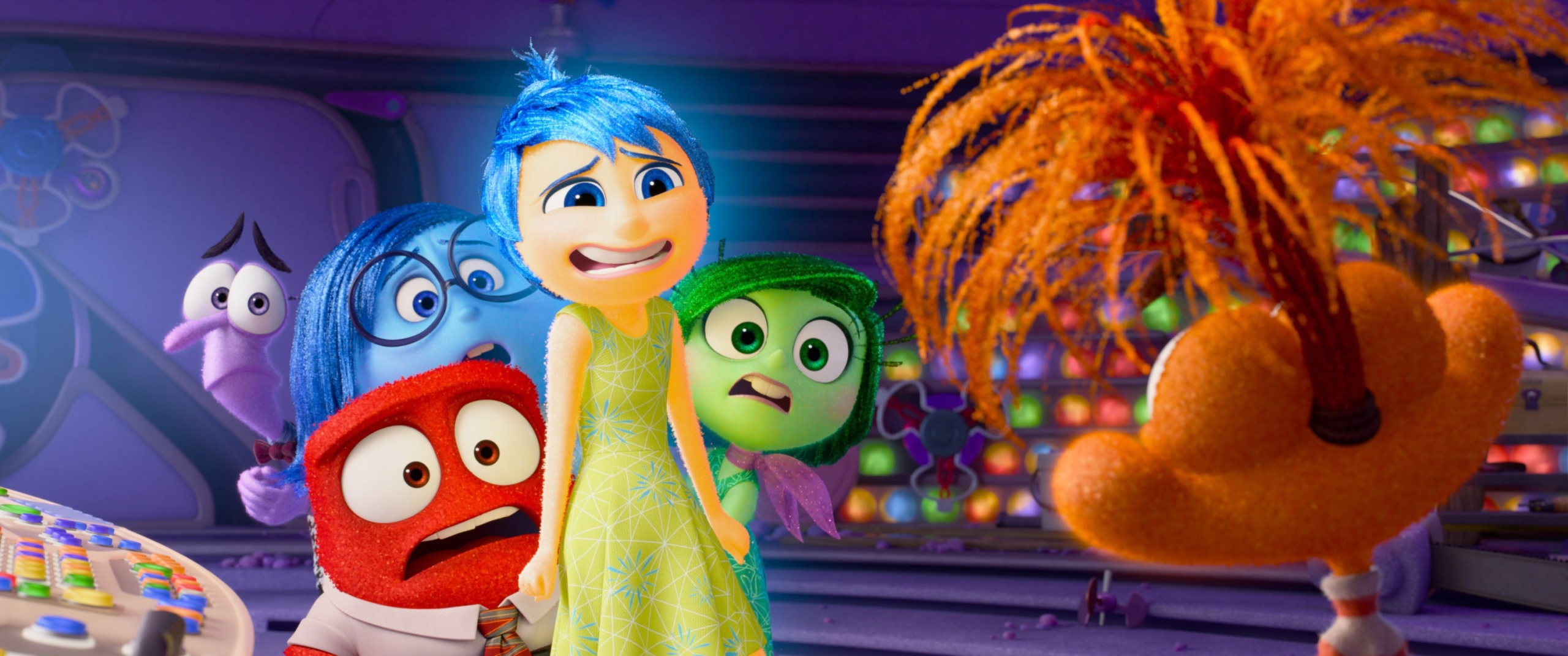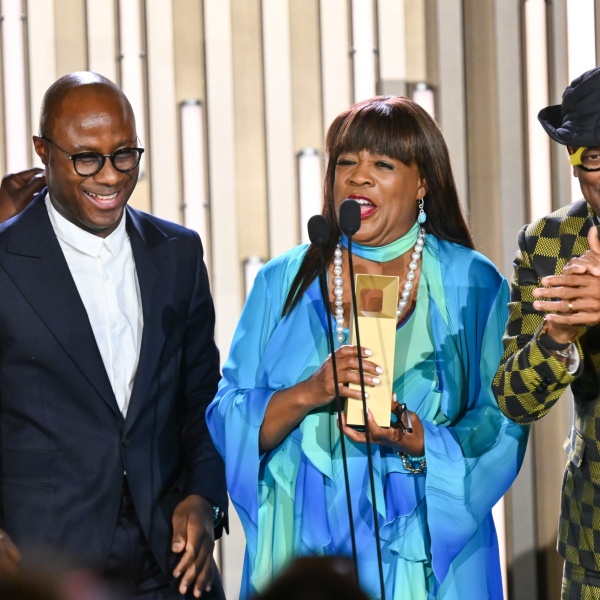Hollywood was on tenterhooks before this make-or-break box office weekend. But Pixar‘s “Inside Out 2” delivered and then some, with a rousing $155 million domestic gross plus $140 million international, the best opening of the year so far, and since last year’s “Barbie.” Screenwriter Meg LeFauve, nominated in 2016 for writing the Oscar-winning animated original, rejoined Pixar for the sequel, starting before the pandemic pushed animated releases onto streaming. Now, Disney and Pixar are luring audiences back into theaters.
“We didn’t know what was coming,” LeFauve said on Zoom. “The only pressure was it had to be sequel-worthy Pixar. You have to explain why. Can we go to new places and discover new things in this world? And can we dig into something personal and emotional and vulnerable to share?”
At Pixar, the writing process for an animated feature is radically different than live-action movies. First, there’s the Brain Trust. Led by Pixar chief Pete Docter, who dreamed up “Inside Out” in the first place, it’s a changing group of animators who give periodic feedback at each stage of the process. Sometimes, the all-stars show up, like “Wall-E” creator Andrew Stanton, or “Coco” director Lee Unkrich.
“The Brain Trust is always evolving, because it is a living thing in terms of who’s at Pixar at that time,” said LeFauve. “Who’s working on what projects; can they take time off to come into a Brain Trust? Pete Doctor is the creative leader but is attuned to the same philosophies of a Brain Trust of getting multiple voices creatively to turn it up and give you ideas and places to look and maybe blind spots. So that has stayed much the same.”
“Inside Out 2” director Kelsey Mann pitched three ideas to Docter, but the Anxiety emotion story was clearly the one. “Kelsey went to the personal, to himself,” said LeFauve, “and was vulnerable talking about himself at that cusp [of adolescence]. He showed me pictures of himself when he was six and had a birthday party (‘Look at me!’) and the next birthday party, he’s getting a little bit more remote; by the time he’s 13: ‘I wish everyone would just go away.’ I was like, ‘Oh, yeah, that’s me.’ My dad called me Moody Meg. I can relate.”
Mann and LeFauve’s first task was to convince Docter and the Brain Trust that with the advent of puberty, Riley needed to add new emotions like Anxiety, Envy, Embarrassment, and Ennui to the core group: Joy, Sadness, Anger, Fear, and Disgust. At the beginning, when the writers are trying to find a movie, the Brain Trust starts small. “I want to investigate anxiety, but what’s the story?” said LeFauve. “Pixar is all about, ‘Is this the best story?’ It’s about iteration, and it’s about fail fast. So you’re always pushing, pushing, pushing out to the edge of your creativity. They want you to fail, because then they know you’re trying for something, but fail fast, because we’ve got to get a movie going here. At the beginning we’re at that delicate stage of putting together our ideas.”

And then once you have an outline, “or a scriptment,” said LeFauve, “then you have a larger Brain Trust, because now you’re ready to go to script. And then you go to script, and you have another one. And those can blow up. They can be ‘we like this half,’ or ‘this could be the best thing ever, go forward.’ You never know what you’re going to get. But there’s always good ideas coming. From the script, you’re churning, churning, churning, and then they’re starting to draw, you have to have some character design going on.”
They wrote more emotions than they could use. LeFauve tried to bring back one of her favorites cut from the first, Schadenfreude, German of course. But he still didn’t make the cut. They did get to keep French Ennui. But Procrastination Land went by the wayside. “Oh, it was so fun,” said LeFauve. “But it didn’t add to the story. It didn’t add to Joy’s journey or Riley’s or Anxiety’s. You start to understand: we want to be with these emotions. And we care more deeply for Anger and Fear and Disgust. It’s about Riley. What do we need to tell their story?”
The next phase is the storyboard. “Once you start going into storyboard,” said LeFauve, “now you sequence it. I always know as a writer if the scene is good, because the storyboard artist is so excited to draw it. So that’s always a good day. And then you go into your screening process, and you screen the movie within Pixar in storyboard format, and go back into those Brain Trusts.”

Then they start making a movie and play the whole thing through each time, no matter how finished the sections are, using voices from inside Pixar. Pete Docter’s temp voice as Anger inside the head of Riley’s father is in the final movie. LeFauve is too busy writing to do any dubbing. “And then you do the screening with a Brain Trust, because you’re pushing,” she said. “Things will blow up, things will go backwards, things will go incrementally forward. What I’ve learned there as a writer: It’s tempting to go back to your draft, and take the notes and look at them and noodle around. But at Pixar, especially in those early versions, you go back to outline, you see those notes as symptoms. You’ve got to go back to the core engine of your story. And we go all the way back and we rebuild it. You rebuild the whole movie. It’s what’s best for the story, honestly. And we’re fighting for the story. And we’re fighting for the characters and they need us to be that brave. So you’re doing that deep, deep work. It seems like it’s going to be longer, but it’s actually faster to do it that way. Because if you don’t do it that way, you get a Band-Aid Monster. Those aren’t organically stories that are great stories.”
Of course, it can be overwhelming to have all these people giving feedback. So LeFauve always waits a day or two and then goes back to her director. “‘What’s staying with you? ” she asks. “‘What’s ringing true to you? What about the movie you want to make?’ And now my job as a writer is to go deeper into that and help us find that movie based on what we now know.”
One thing Pixar knows is not to shy away from intensity. When Anxiety goes into swirling panic attack mode, Riley is sitting quietly by the hockey rink in the penalty box. “It’s a beautiful picture because it’s human,” said LeFauve. “And, yes, anxiety is uncomfortable. And that end is uncomfortable. If you are comfortable than you shouldn’t be, we didn’t do our job, right? But there’s such a beauty in knowing you’re not alone. And there’s a beauty in what Anxiety is doing in that moment because she is trying to help and realizing she’s gone too far. And that beautiful whirlwind is Kelsey Mann, our director, deeply understanding what it feels like, being able to visualize it so beautifully.”
Riley the hockey player was originally a figure skater in the first movie, until they figured out it was “too presentational,” said LeFauve. “It’s not active enough. Something about it just doesn’t feel right. And so we just opened it up.” That’s when hockey came in. “And we all got very excited. Riley led us back to hockey, she wanted to be out on the ice; it gave us a chance to do that hockey camp. It is school, and learning about herself, and her skill.”

The main reason LaFauve and Mann steered away from focusing on boys was that “hormones are like a physical thing and the mind is symbolic,” said LeFauve. “Pete Docter created a symbolic place; it’s not chemicals and cells going by. It’s a metaphor. And we always had to be careful of that in terms of the language of the film. I didn’t want to center a whole movie around her liking a boy. Because for me, it’s a piece of that age, but it’s sure as heck not all that age. You’re moving away from your family as the epicenter to girls and friends and even the boys that you might all like and whisper about, it’s still filtering back through that girlfriend. That’s where we decided to center it.”
One thing people ask about “Inside Out 2,” as the emotions frantically push the buttons in Riley’s psyche, is just who is running the show? “They’re trying, in all good faith, to construct her and decide who she is,” said LeFauve. “I don’t think they understand that that’s what they’re doing. But that’s what they’re doing. And that’s what parents can do, sometimes; we can decide, well, ‘we need to keep our kid happy,’ or ‘we need to get rid of that anxiety,’ or ‘just don’t think about that. Think about the good stuff.’ But part of finding out who you are is embracing or at least acknowledging all of those things. So for example, envy. People think, ‘Well, I shouldn’t be envious,’ but envy is telling you what you want. It’s important. And you are imperfect. And how beautiful it is that you’re imperfect. And that’s part of what makes you so unique and who you are as well.”

LaFauve also writes other movies that are not Pixar. She and Nicole Perlman wrote “Captain Marvel” (Marvel/Disney), another pressure-cooker assignment. “You feel the weight of the world on your shoulders because you have to create a character for every woman,” LeFauve said, “and you’re in the corner. ‘We have to stop this. We just have to create a character, a person, a human who we relate to.’ Because it got loud.”
Some time back, LeFauve optioned the beloved Ruth Stiles Gannett children’s series “My Father’s Dragon,” and eventually wrote the Nora Twomey animated Cartoon Saloon feature, released by Netflix. “It’s a deep part of myself that you can carry a symbolic backpack with everything you need in it,” she said. “It is such a beautiful metaphor for being human as you move through your life.”
Next up: Now she’s collaborating with a new writing partner, her screenwriter husband Joe Forte, on action horror flick “BackTrack” (Sony). “We’ve joined forces,” she said. “And we’re having a blast. But it’s working. And it’s upping my game.”


